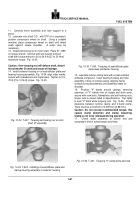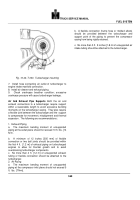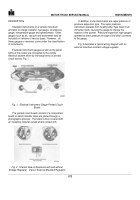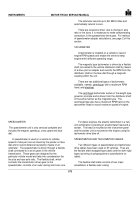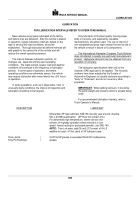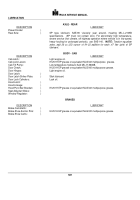TM-5-3805-254-14-P-2 - Page 582 of 894
INSTRUMENTS
MOTOR
TRUCK SERVICE MANUAL
Fig. 22.
Fuel Gauge Circuit
Fuel Level Gauge:
The electric fuel gauge system consists of two basic
components the dash gauge and the gas tank sending
unit.
The dash gauge indicates the quantity of fuel in the
gas tank, while the tank unit controls the gauge.
The two
units are connected electrically as shown in Fig. 22.
The fuel gauge is of the air core type.
The air core
gauge consists of three (3) copper wire coils that are
wound around a plastic bobbin containing a magnet and
spindle assembly.
Attached to the magnet and spindle
assembly is a pointer which indicates the fuel level.
The
fuel gauge requires a 0 to 90 ohm resistance sender to
operate.
The sender is the tank unit.
The tank unit
consists of a float and arm assembly and a variable
resistor.
The sender’s resistance is controlled by the
position of the float and arm assembly.
A full fuel tank
raises the float to its highest position.
At this position the
variable resistor has a resistance of 88 to 92 ohms.
With
an empty fuel tank the float assumes its lowest position,
creating a sender resistance of less than 1 ohm.
Electrical current, supplied by the battery, travels
through the ignition switch and enters the fuel gauge at
point A, Fig. 22.
At point A the current divides between
the "calibrating resistor’[ and the "empty coil" as it flows
to point B.
From point B two possible paths exist to
complete the circuit to ground.
The current flows through
the series connection of the "Bucking Coil" and the "Full
Coil" to ground or it can travel through the tank unit.
Since current will travel through the path of least
resistance, the flow is determined by the resistance of
the sender.
When the fuel tank is empty, the tank unit has a
resistance of 0 ohms.
Since this resistance is smaller
than the combined resistance of the bucking and full
coils, the current flows through the tank unit.
The current
flow through the empty coil creates a magnetic field
around the coil.
This field attracts the magnet which is
on the same spindle as the indicating pointer and rotates
the pointer toward the empty scale reading.
When the
fuel tank is full, the tank unit has a resistance of 90
ohms.
As the current reaches point B, it seeks a path
through the series connection of the bucking coil and the
full coil to ground, since their combined resistance is less
than that of the tank unit.
All of the three coils now have
a magnetic field induced by the current flow; however,
the empty coil and the bucking coil are wound in opposite
directions.
This causes their respective magnetic fields
to cancel each other.
The remaining effective field
around the full coil attracts the magnet, thus rotating the
pointer to the full scale reading.
Fig. 23.
Fuel Level Gauge
576 A
Back to Top

